
Improv aplenty in Whose Line Is It Anyway?
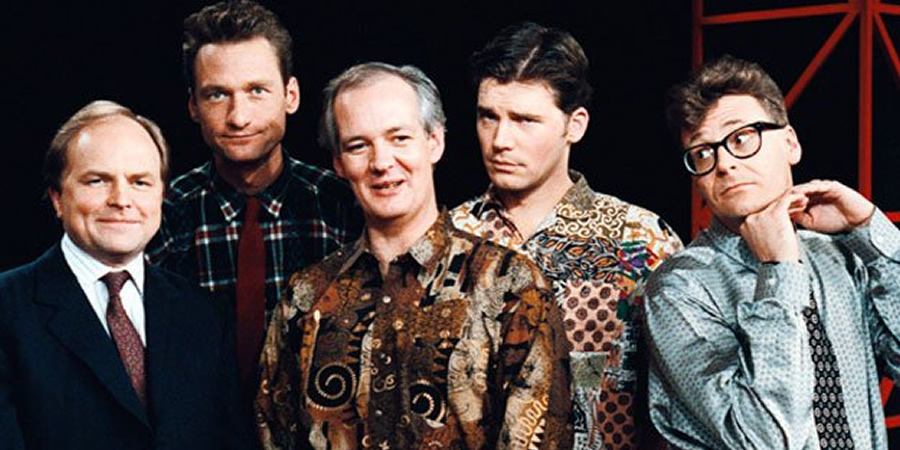
Friday nights on Channel 4 in the Nineties would not have been the same without Whose Line Is It Anyway?: the popular improvisational comedy ran for ten series and 136 programmes between 1988 and 1999. For just over a decade, viewers eagerly switched on to enjoy such delights as Josie Lawrence singing a song about a barbecue in the style of Edith Piaf, Tony Slattery pretending to host a party for Ryan Stiles with the latter in the guise of a toddler cheerfully learning to walk, or the likes of Greg Proops or Sandi Toksvig dreaming up scenarios involving the "worst ever person to be stuck on a desert island with".
Every single episode was hosted by onetime barrister, Clive Anderson, who soon became a household name as a result. Most of the shows featured the talented musician Richard Vranch as the resident musician who could improvise a variety of different musical styles on a range of instruments at the drop of a hat.
The games were simple. 'Authors,' for example, would require each performer to take turns telling a continuous story in the style of a particular writer, maybe Marcel Proust, Jackie Collins or perhaps even Dr Seuss. 'Film and Theatre Styles' was a more physical version of this with performers switching between portraying say, a blind date or a job interview in the style of a Greek tragedy, a Carry On film or a sci-fi adventure every time Anderson pressed the buzzer. 'Sound Effects' (which Ryan Stiles and Colin Mochrie excelled at) would see one performer silently miming a scene, while another performer cleverly added their own accompanying vocal sound effects as they watched. 'Party Quirks' would see a performer attempting to identify a series of unusual party guests ranging from Archie Hahn simply playing a werewolf, Mike McShane as someone "who has fallen in love with the camera" to Colin Mochrie playing all seven dwarves at the same time. A skilled performer such as Paul Merton or Tony Slattery could often manage to be equally funny even when playing the 'straight man' role of hosting the party. 'Questions only,' meanwhile, restricted performers to conversing in a series of questions (prompting Ryan Stiles's confusing query, "is Ted Danson?") while rounds such as 'Bartender' or 'Hoedown' gave players, notably the talented Josie Lawrence an opportunity to demonstrate their musical improvisation skills. And these were just some of the games. There were many more.
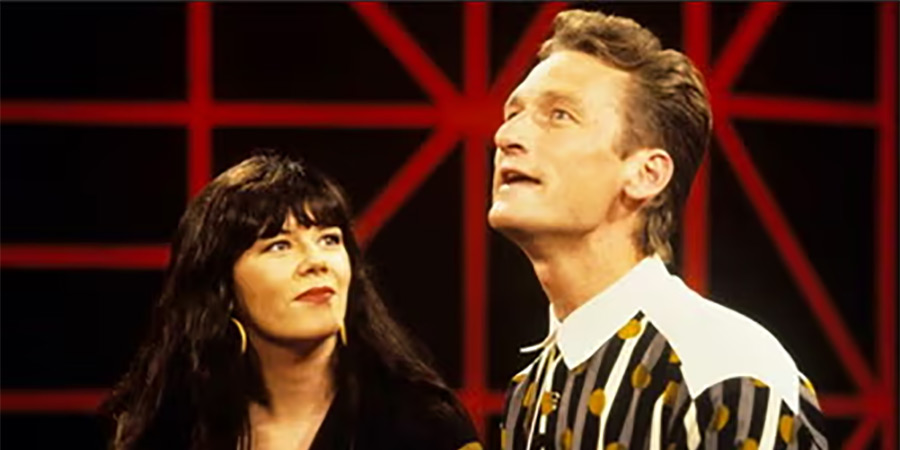
Ultimately, however, the story of Whose Line Is It Anyway? begins with two men: Dan Patterson and Mark Leveson. The pair had met while attending a Jewish youth group as teenagers in 1974. They stayed in touch throughout university and by 1988 were working for BBC Radio 4. For, yes, as with the likes of The Mary Whitehouse Experience, Hancock's Half Hour, Alan Partridge, Little Britain and The Day Today, Whose Line Is It Anyway? is one of the many great British comedies to have begun life on the wireless.
There had already been something of an improv craze in the US. This had spread to the UK with talents like Lawrence, Vranch and Merton making an impact with the Comedy Store Players, which had started in 1985. Patterson and Leveson hoped to bring improv to a wider audience. The name of their new show, incidentally, was a play on the title of Brian Clark's sombre piece of theatre, Whose Life Is It Anyway?.
The original radio pilot aired in 1988 and immediately created something of a sensation. After a short six-episode run, there was swift talk of transferring the format to TV. With Clive Anderson already chairing, the pilot featured the dream line-up of Lenny Henry, Dawn French, Stephen Fry and John Sessions. Lenny and Dawn would, as it turned out, (and despite much encouragement) never appear on the show again, either on radio or TV. Fry's colleague, Hugh Laurie, was persuaded to appear on one radio episode; but with Anderson, Fry and Sessions all on board, preparations began for the show's TV debut.
Then, suddenly, disaster: both Fry and Sessions announced they were pulling out in quick succession. Producers Paterson and Leverson despaired. Would Channel 4 even want the show now? Thankfully, they (assisted by Fry) managed to persuade Sessions to change his mind over a nice dinner. This was probably crucial: although slightly less well-known than rising star Fry at the time, Sessions was an extremely talented and literate figure. He dominates the early series of the TV version to such an extent that it's hard to imagine it taking off in quite the same way without him. Fry would, of course, become considerably more famous over the next decade, and though never a regular would drop in a total of seven times during the TV show's long run. Always quick-witted, Fry's appearances usually contained a fair share of magic moments, despite frequently demonstrating his clear insecurities about his lack of musical talent.

Watching it today (it did not air at the time), the 1988 TV pilot of the format contains most of the elements viewers would come to grow familiar with. True, the set is even more minimalist than it was later, and the opening title sequence gives the impression that what follows will basically be The John Sessions Show, but in most other respects this was exactly the programme audiences would grow to love. The pilot saw Sessions joined by another figure who would become a star of the show, Josie Lawrence alongside Jimmy Mulville and Jon Glover. Liverpool-born Mulville was a familiar comedy face at the time thanks to shows like Who Dares Wins... and the sitcoms That's Love (which featured future WLIIA? regular Tony Slattery) and Roman Britain-set Chelmsford 123 (which also featured Philip Pope, the man behind the new improv show's lively theme tune). Mulville would appear only a few times on the show itself but as a co-founder of Hat Trick Productions, the independent company who made the series, has undoubtedly made an essential contribution to WLIIA? history. The final contestant, Jon Glover, meanwhile, was best known for providing voices for the latex lampoonery of Spitting Image. Despite theoretically "winning" the pilot episode, Glover would never appear again.
As the series proper began, the show slowly got into its stride. The premise was simple. Clive (who is visibly nervous in the early episodes) would introduce each round, often taking suggestions from the audience as to their content. Unlike many panel shows, there was never any real sense of competition between performers thanks to Clive's tendency to award and deduct points for each round entirely arbitrarily ("a million points to everyone there... except Greg"). The only "prize" was the opportunity to read out the closing credits in the style of Clive's choosing (for example, in the style of an angry mother shouting out to her children in the street or in the guise of an angry viewer complaining to Channel 4). In later years, incidentally, these credits would often include the then-unknown name Richard Osman, who had an early behind-the-scenes job as 'programme associate' (in other words, a contributing writer) on the show.

As the years rolled by a number of talented individuals made their mark on the Whose Line Is It Anyway? stage.
Whilst RADA graduate and Spitting Image regular John Sessions was almost the face of the show during its early, more literary phase (excelling particularly during the Authors round), he departed for good in 1991, having recorded 24 programmes. A regular performer with the Comedy Store Players, Josie Lawrence, meanwhile, was still in her twenties when Whose Line...? started but quickly made an impact as one of the show's major stars. She was particularly feted for her musical contributions: for example, by singing a song about brushing her teeth in the style of an Italian opera. A formidable talent, Lawrence appeared on the show 54 times, far more than any other female performer. Despite a distinguished stage and screen career in the years since, she remains strongly associated with the show in the public mind.
The famously deadpan Paul Merton was another Comedy Store Player who made his name on Whose Line...?. Merton admits to having a panic attack during one episode of the show (he was in fact suffering from a brief bout of psychiatric problems caused by anti-malaria medication he had taken whilst on holiday), but became established as one of the early stars of the series thanks to his quick-witted responses to such scenarios as 'two beetles making love on a leaf' ("you know, I've always liked you, Ringo..."). Due to the rapid growth of his solo comedy career - largely as a result of his team captaincy on Have I Got News For You from 1990 - Merton stopped appearing on WLIIA? after 1993 (he had by then appeared twenty times), although his then wife, Men Behaving Badly star Caroline Quentin, enjoyed a successful ten appearances during 1995 and 1996 alone.
Some took against the early, more erudite feel of show. In 1990, an edition of Viz comic strip Roger Mellie - The Man on the Telly parodied the programme as insufferably smug, with Roger taking against a twitchy Clive Anderson during an appearance and ultimately punching John Sessions. Whether this had any impact or not, the show did become notably less highbrow and generally more fun as the years rolled by.

Although often brilliant, Tony Slattery gained something of a reputation for lowering the tone of proceedings both on Whose Line Is It Anyway? and elsewhere thanks to his penchant for adult humour. Spitting Image made a running joke of the fact that Slattery never seemed to say "no" to TV work: indeed, Slattery was the most prolific British male performer on the series, appearing 49 times between 1988 and 1995. Sadly, watching Slattery's later appearances today, it is all too obvious he was starting to suffer from the well-publicised personal problems which would plague him through much of the rest of his life. One episode, for example, saw him drop the 'F-bomb' (still generally considered taboo on UK TV in the mid-Nineties) while talking angrily to Anderson, and he seemed increasingly agitated and sweaty on stage.
After struggling to identify Ryan Stiles's superb rendering of a series of animals being caught in car headlights during a game of Party Quirks in 1995, an agitated Slattery snatched Clive's script and read out the answer himself. Anderson, who had been visibly losing patience with Slattery throughout the game quipped that Tony "would never be on the show ever again". But it would not prove to be a joke and Slattery was fired mid-series. It was a sad end to a glittering career on the programme. His departure had wider implications when fellow performer Mike McShane quit in solidarity, appearing in only one single further episode in 1997. The American McShane (whose most high-profile role has been playing Friar Tuck in the Nineties movie blockbuster Robin Hood: Prince Of Thieves) had himself been one of the show's most prolific participants, appearing a whopping 43 times.
By now, the WLIIA?'s success had spawned several other new programmes. John Sessions starred in the one-man TV shows John Sessions (1989), John Sessions's Tall Tales (1991) and John Sessions's Likely Stories (1994), although these moved away from improv into a series of short plays. An exceptionally talented and erudite man, his stage and screen career continued until his early death in 2020.
Josie Lawrence, meanwhile, depicted a variety of different comic creations of her own in Josie in 1991, a series of six comic playlets. The scripts were co-written by Lawrence and her WLIIA? co-stars Paul Merton and Arthur Smith, with extra musical support from Vranch. That same year also saw Slattery and Mike McShane doing more improv in their own short-lived show, the cheekily-named S&M. McShane returned with his WLIIA? co-star Sandi Toksvig in 1992 sitcom The Big One. Now a very familiar TV face, Toksvig had appeared in 15 editions of the improv show - more than any other woman aside from Lawrence. Although not a huge success, The Big One successfully exploited the great physical contrast between the taller, fatter McShane and the diminutive Toksvig.
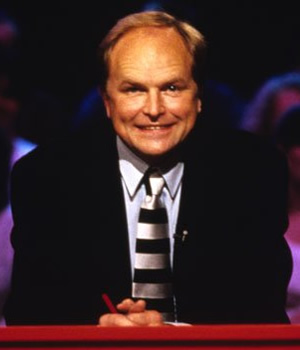
Finally, although neither were in any sense spin-offs, it is unlikely either Paul Merton - The Series (1991-93) or the chat show Clive Anderson Talks Back (1989-96) would ever have existed had Whose Line Is It Anyway? not first made them stars.
Improv is not for everyone, of course, and at least as significant as those who appeared many times are those who appeared on the show only once: a distinction held by Eddie Izzard, Chris Langham, Peter Cook, Julian Clary and ex-Goodie Graeme Garden. Not all of these were necessarily bad (Izzard, for example, was going through a phase of trying not to appear too often on television) but some were. The case of Cook proved to be a sad one. By all accounts, in the run-up to recording in 1988, Cook was on brilliant form demonstrating all the quick wit and sharp intelligence that had made him a star during his 1960s heyday. Unfortunately, before filming, Cook went for a drink with fellow performer Rory McGrath. By the time the cameras switched on the alcohol had clearly done its work, leading to a disappointing performance. He never appeared again.
A number of other stars appeared only occasionally. Griff Rhys Jones, Arthur Smith, Jan Ravens, the aforementioned McGrath and a Father Ted-era Ardal O'Hanlon are all amongst those who appeared two or three times; renowned actor Jonathan Pryce appeared a total of six times.
The show was undeniably authentic. Even fairly regular performers such as Stephen Frost or Stephen Fry could crash and burn during a particularly difficult hoedown, the results mercilessly apparent to studio and TV audiences alike. It never mattered. The sense of easy-going fun was always there.
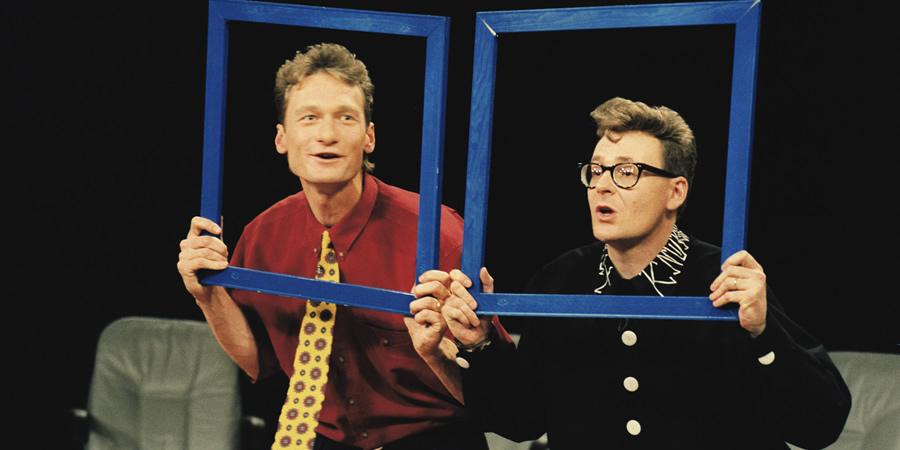
The role of Americans on the show was also always important. Although barely mentioned here so far, Arizona-born Greg Proops appeared on the show 67 times, almost more than anyone else. Proops delighted in making barbed remarks to Clive during his years on the show, hunching his shoulders and adopting an English accent when invited to portray, 'the world's worst person to be a TV presenter' and declaring, "hello, my name is Clive Anderson!"
During the later years of Whose Line Is It Anyway?'s run the roles of American-Canadian Ryan Stiles and his friend, the Scots-Canadian Colin Mochrie, became crucial. While both appeared separately on the show during its early years, it was soon recognised that the two had a brilliant rapport and worked best when appearing together. Stiles, in particular, could be wonderfully inventive, vividly depicting a recently caught fish, while Mochrie rose to the challenge of portraying the history of the world in one minute during a game of Party Quirks. In the show's final few series they became a permanent fixture, appearing in more episodes than anyone else, save Anderson and Vranch. Stiles appeared 92 times, Mochrie 71.
However, Whose Line Is It Anyway?'s 1988 to 1999 run was really only the start of the story, the format having been produced almost continuously in the United States since 1998, aside only for a six-year hiatus between 2007 and 2013). At the time of writing, there have been 21 seasons and well in excess of 400 episodes aired.
The American version is, of course, different in many ways. The humour is not the same. Clive Anderson has never been on it and that the show has instead been presented by Drew Carey and Aisha Tyler will mean little or nothing to most British viewers. But impressively, though both are now well into their sixties, popular favourites Ryan Stiles and Colin Mochrie continue to appear every week. Stiles has only ever missed three of the US episodes to date, and Mochrie not one.
Dan Patterson and Mark Leveson, meanwhile, went on to create the long-running topical panel show Mock The Week, which ran between 2005 and 2022 (Greg Proops and Rory Bremner enjoy the rare distinction of having appeared on both MTW and WLIIA?). Ultimately the tale of Whose Line Is It Anyway? is an unusual story of British comedy past as well as of America's comedy present.
Where to start?
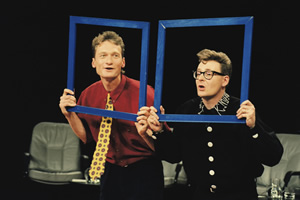
Series 4, Episode 2
Really no special introduction is needed as with the rules to every game explained clearly, every episode is immediately accessible. However, this episode from 1992 captures a moment when the show had abandoned its early literary pretentions and was really getting into its stride with a classic line-up including Greg Proops, Paul Merton, Ryan Stiles and Josie Lawrence.
Help British comedy by becoming a BCG Supporter. Donate and join us in preserving, amplifying and investing in comedy of all forms, from the grass roots up. Advertising doesn't cover our costs, so every single donation matters and is put to good use. Thank you.
Love comedy? Find out moreWhose Line Is It Anyway? - Complete First & Second Series

Make it up. Make it quick. Make it funny!
Whose Line Is It Anyway? began as a radio show in 1987 and due to its success was transferred to television a year later.
The show features four contestants, comedians and actors, who must improvise sketches in order to win points and ultimately win the game.
First released: Monday 25th February 2008
- Distributor: 4DVD
- Discs: 1
![]() Buy and sell old and new items
Buy and sell old and new items
Search for this product on eBay
BCG may earn commission on sales generated through the links above.
- Distributor: 4DVD
- Region: 2
- Discs: 1
![]() Buy and sell old and new items
Buy and sell old and new items
Search for this product on eBay
BCG may earn commission on sales generated through the links above.
Whose Line Is It Anyway? - The Complete BBC Radio Series

The hit improvisation radio show that spawned the TV phenomenon.
Regular team captains Stephen Fry and John Sessions are joined by Lenny Henry, Dawn French, Hugh Laurie, Enn Reitel, Jimmy Mulville, Nonny Williams, Griff Rhys Jones, Kate Robbins, John Bird, Rory Bremner and Jon Glover, as they battle their way through a succession of games and romp through a world of literary styles, TV theme tunes, and film genres.
Chairman Clive Anderson desperately tries to hold the whole thing together and the guests make it up as they go along in this riot of improvisation.
First heard on BBC Radio 4 in January 1988, Whose Line Is It Anyway? went on to run for 10 series on Channel 4 and found success in America.
Based on comedy suggestions from the studio audience, this is ad-libbed comedy at its best. With Colin Sell at the piano.
First released: Thursday 17th September 2020
- Distributor: BBC Digital Audio
- Minutes: 180
BCG may earn commission on sales generated through the links above.

